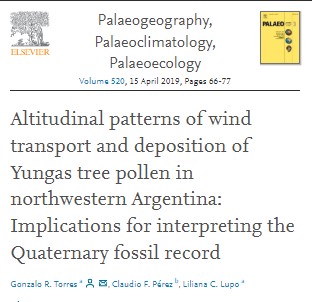Altitudinal patterns of wind transport and deposition of Yungas tree pollen in northwestern Argentina: Implications for interpreting the Quaternary fossil record
Bosque Modelo:
Jujuy
Temática:
Conservación
Tipo de documento:
Artículo científico
Resumen
The presence of pollen from Yungas tree species in fossil sequences located above the tree-line has led to alternative interpretations of past climate changes in tropical and subtropical Andes. We studied atmospheric and surface pollen deposition rates of Yungas trees along an altitudinal gradient (1700–3800 m a.s.l.) to understand the role of local wind patterns in modern pollen transport to mountain regions. Pollen from the Montane forest (Alnus and Juglans) and the Montane rainforest (Anadenanthera, Celtis and Myrtaceae) becomes airborne and is transported upslope well above the tree-line. The resulting patterns of pollen deposition show a secondary maximum in the Montane grassland, consistent with the development of a mountain-valley breeze system during the flowering period of the pollen producer species. Given that the pattern is also preserved in the surface sediment, we propose that these tree pollen types are good indicators of mesoscale atmospheric circulation and could provide a proxy for this circulation system in Quaternary records. This alternative approach to interpreting fossil pollen records of Yungas species in highlands of the Central Andes has implications for regional reconstructions of past climate.
Información Bibliográfica
Autor:
Gonzalo R Torres, Claudio F Pérez, Liliana C Lupo
Revista:
Palaeogeography, Palaeoclimatology, Palaeoecology
Año:
2019
N°:
-
País :
Argentina
Páginas:
66 - 77
Volumen:
520
Idioma:
Ingles
Palabras claves
Paleontology, Yunas tree,





